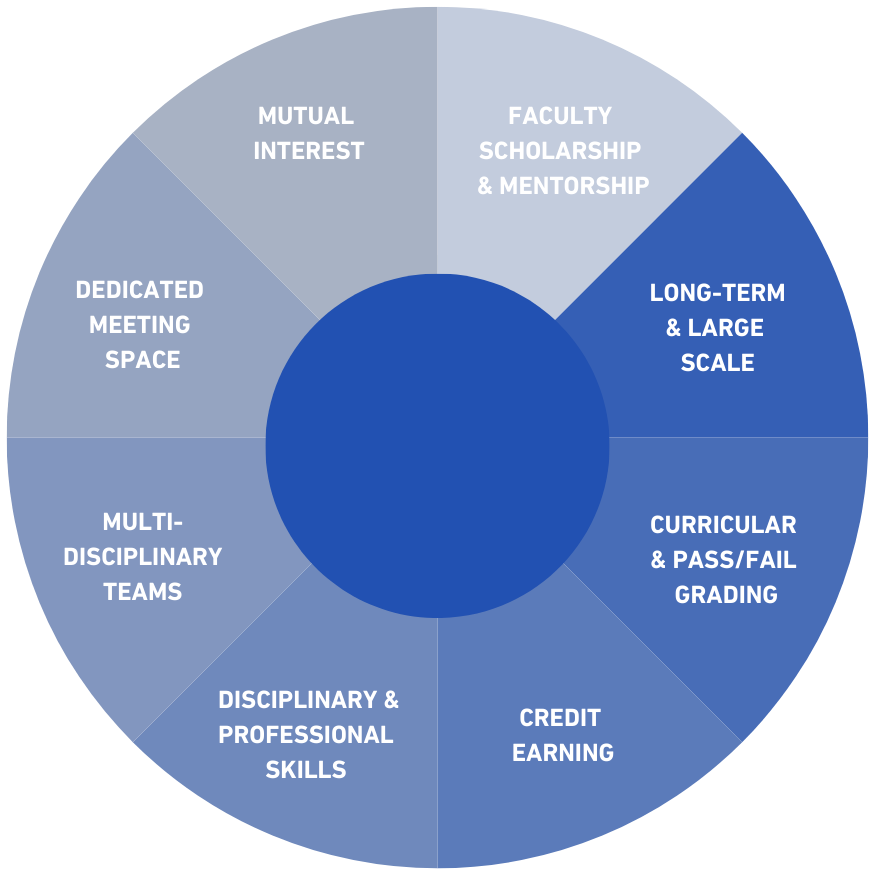
The Essential Elements
The VIP Model can be implemented in most higher educational institution settings, and adapted to fit the needs of different student bodies, resources and school structures.

The Essential Elements
BUILDING BLOCKS FOR VIP PROGRAMS
To create a VIP structured program, institutions must implement the essential elements of the VIP model as identified by the Consortium.
Learn more about each element below.
FACULTY SCHOLARSHIP & MENTORSHIP
Projects are embedded in faculty mentor’s scholarship and exploration. Full faculty engagement underlies the success of VIP. To sustain full engagement over many years, projects must be homed in the faculty mentor's area of interest.
LONG TERM & LARGE SCALE
Projects are long-term and large-scale, continuing for many years, even decades. The VIP team model allows for larger-scale and longer-term projects than a single semester or year would permit. This allows faculty to take on more ambitious projects; it gives new students experience in getting up to speed on an existing project (as they'll likely do in the workplace); and it gives returning students leadership experience, as they help on-board new members.
CURRICULAR & PASS/FAIL GRADING
Program is curricular and all participating students are graded (A-F; not P/F or S/U). VIP is not a club, but a credit-bearing course that counts toward students' degree requirements. Letter grading holds students accountable for their work. In many ways, feedback and grading in VIP is like an evaluation in the workplace. Work is evaluated, guidance is given, and students have the opportunity to improve.
CREDIT EARNING
Students can participate and earn credits toward their degrees for at least two years. Long-term student involvement is key to team success. When students join a team, they spend much of the first semester getting up to speed. They make their largest contributions in subsequent semesters, both in technical contributions and in team leadership.
DISCIPLINARY & PROFESSIONAL SKILLS
Learning outcomes focus on the development of both disciplinary and professional skills. VIP teams function much like small start-up companies. While students develop and apply skills from their disciplines, they also develop and apply professional skills, important to team functioning and valued in the workplace.
MULTI-DISCIPLINARY TEAMS
Multi-disciplinary teams are encouraged but not required. Multi-disciplinary teams have been a hallmark of VIP programs, giving faculty access to a variety of disciplines and skill sets. In some cases, a VIP site may be limited by departmental or curricular rules, which the consortium recognizes.
DEDICATED MEETING SPACE
Dedicated classroom and meeting spaces. VIP teams differ from traditional classes, and it is important to provide spaces in which the teams can meet and work. Teams typically meet at the same time and day each semester, ensuring team meetings work well with instructors' schedules. Student access to the space outside of scheduled class times allows for sub-team meetings. Rooms are typically set up in conference room style to encourage collaboration.
MUTUAL INTEREST
Faculty/student participation is based on mutual interest. In VIP, students and faculty engage in projects that are of mutual interest, which is key to the success and scalability of VIP programs. Faculty stay actively engaged because teams help advance their scholarship and research and support the work of their graduate students. Students select projects that align with their personal interests. The single most influential factor that predicts student success on a VIP team is the student's enthusiasm for the project.